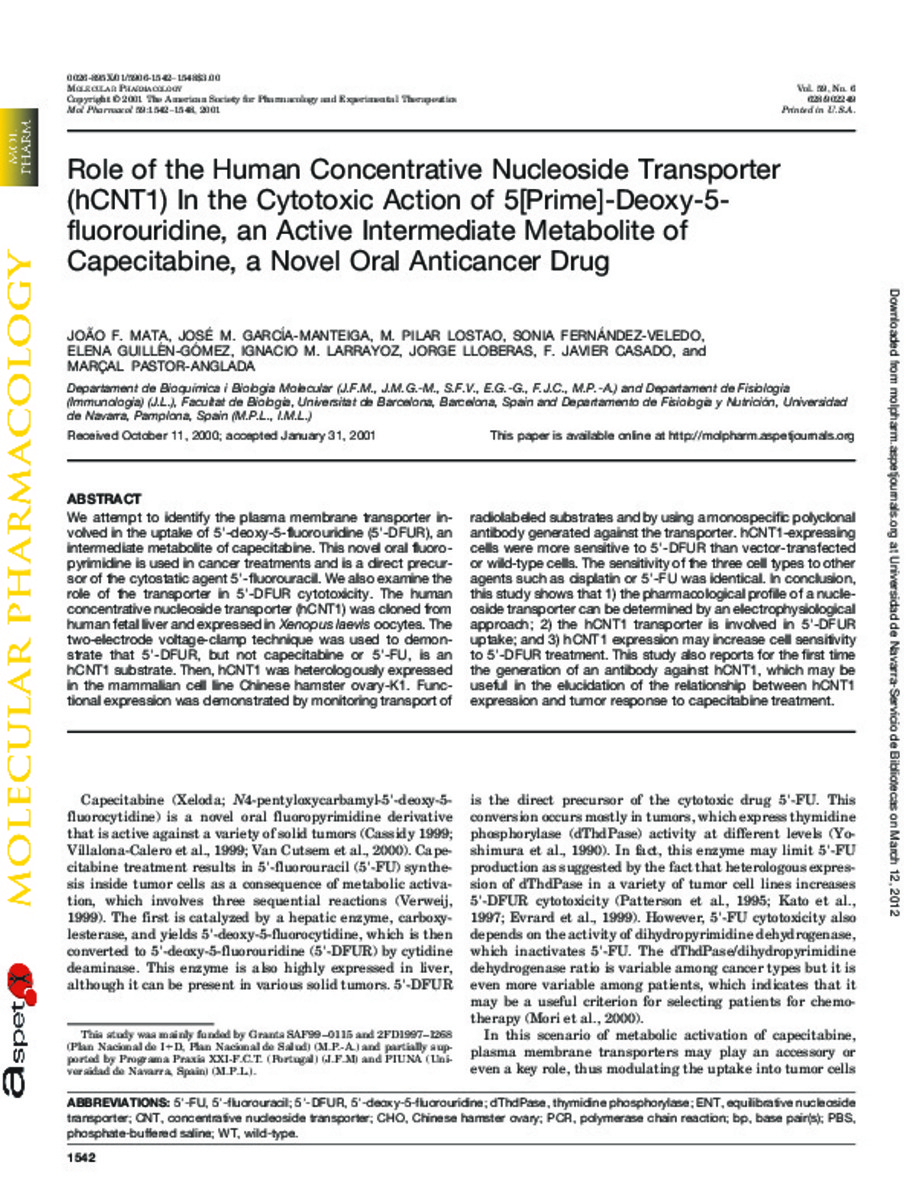Full metadata record
| DC Field | Value | Language |
|---|---|---|
| dc.creator | Mata, J.F. (Joao F.) | - |
| dc.creator | Garcia-Manteiga, J.M. (José M.) | - |
| dc.creator | Lostao, M.P. (María Pilar) | - |
| dc.creator | Fernandez-Veledo, S. (Sonia) | - |
| dc.creator | Guillen-Gomez, E. (Elena) | - |
| dc.creator | Larrayoz, I.M. (Ignacio M.) | - |
| dc.creator | LLoberas, J. (Jorge) | - |
| dc.creator | Casado, F.J. (F. Javier) | - |
| dc.creator | Pastor-Anglada, M. (Marçal) | - |
| dc.date.accessioned | 2012-03-12T17:00:34Z | - |
| dc.date.available | 2012-03-12T17:00:34Z | - |
| dc.date.issued | 2001 | - |
| dc.identifier.citation | Mata JF, Garcia-Manteiga JM, Lostao MP, Fernandez-Veledo S, Guillen-Gomez E, Larrayoz IM, et al. Role of the human concentrative nucleoside transporter (hCNT1) in the cytotoxic action of 5[prime]-deoxy-5-fluorouridine, an active intermediate metabolite of capecitabine, a novel oral anticancer drug. Mol Pharmacol. 2001 Jun;59(6):1542-8. | es_ES |
| dc.identifier.issn | 0026-895X | - |
| dc.identifier.uri | https://hdl.handle.net/10171/21116 | - |
| dc.description.abstract | We attempt to identify the plasma membrane transporter involved in the uptake of 5'-deoxy-5-fluorouridine (5'-DFUR), an intermediate metabolite of capecitabine. This novel oral fluoropyrimidine is used in cancer treatments and is a direct precursor of the cytostatic agent 5'-fluorouracil. We also examine the role of the transporter in 5'-DFUR cytotoxicity. The human concentrative nucleoside transporter (hCNT1) was cloned from human fetal liver and expressed in Xenopus laevis oocytes. The two-electrode voltage-clamp technique was used to demonstrate that 5'-DFUR, but not capecitabine or 5'-FU, is an hCNT1 substrate. Then, hCNT1 was heterologously expressed in the mammalian cell line Chinese hamster ovary-K1. Functional expression was demonstrated by monitoring transport of radiolabeled substrates and by using a monospecific polyclonal antibody generated against the transporter. hCNT1-expressing cells were more sensitive to 5'-DFUR than vector-transfected or wild-type cells. The sensitivity of the three cell types to other agents such as cisplatin or 5'-FU was identical. In conclusion, this study shows that 1) the pharmacological profile of a nucleoside transporter can be determined by an electrophysiological approach; 2) the hCNT1 transporter is involved in 5'-DFUR uptake; and 3) hCNT1 expression may increase cell sensitivity to 5'-DFUR treatment. This study also reports for the first time the generation of an antibody against hCNT1, which may be useful in the elucidation of the relationship between hCNT1 expression and tumor response to capecitabine treatment | es_ES |
| dc.language.iso | eng | es_ES |
| dc.publisher | American Society for Pharmacology and Experimental Therapeutics | es_ES |
| dc.rights | info:eu-repo/semantics/openAccess | es_ES |
| dc.subject | Xenopus-Laevis oocytes | es_ES |
| dc.subject | Thymidine phosphorylase | es_ES |
| dc.subject | Colorectal cancer | es_ES |
| dc.subject | B-Lymphocytes | es_ES |
| dc.subject | Cells | es_ES |
| dc.subject | 5'-deoxy-5-fluorouridine | es_ES |
| dc.subject | Tumors | es_ES |
| dc.subject | Liver | es_ES |
| dc.title | Role of the human concentrative nucleoside transporter (hCNT1) in the cytotoxic action of 5[Prime]-deoxy-5-fluorouridine, an active intermediate metabolite of capecitabine, a novel oral anticancer drug. | es_ES |
| dc.type | info:eu-repo/semantics/article | es_ES |
| dc.relation.publisherversion | http://molpharm.aspetjournals.org/content/59/6/1542.long | es_ES |
| dc.type.driver | info:eu-repo/semantics/article | es_ES |
Files in This Item:
Statistics and impact
Items in Dadun are protected by copyright, with all rights reserved, unless otherwise indicated.






